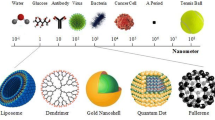Abstract
High concentrations of cationic colloidal silica nanoparticles (CCS-NPs) have been widely used for the enrichment of plasma membrane proteins. However, the interaction between the CCS-NPs and cells under the required concentration for the isolation of plasma membrane are rarely investigated. We evaluated the internalization and toxicity of the 15 nm CCS-NPs which were exposed at high concentrations with short time in human breast cancer cells (MCF-7) with transmission electron microscopy, energy dispersive X-ray spectroscopy, inductively coupled plasma atomic emission spectroscopy, and colorimetric assays. The NPs were observed throughout the cells, particularly in the cytoplasm and the nucleus, after short incubation periods. Additionally, the NPs significantly influenced the membrane integrity of the MCF-7 cells.





Similar content being viewed by others
References
Aillon KL, Xie Y, El-Gendy N, Berkland CJ, Forrest ML (2009) Effects of nanomaterial physicochemical properties on in vivo toxicity. Adv Drug Deliv Rev 61:457–466
Alkilany AM, Murphy CJ (2010) Toxicity and cellular uptake of gold nanoparticles: what we have learned so far? J Nanopart Res 12:2313–2333
Arvizo RR, Miranad OR, Thompson MA, Pabelick CM, Bhattacharya R, Robertson JD, Rotello VM, Prakash YS, Mukherjee P (2010) Effect of nanoparticle surface charge at the plasma membrane and beyond. Nano Lett 10:2543–2548
Bouwmeester H, Dekkers S, Noordam MY, Hagens WI, Bulder AS, de Heer C, ten Voorde SE, Wijnhoven SW, Marvin HJ, Sips AJ (2009) Review of health safety aspects of nanotechnologies in food production. Regul Toxicol Pharmacol 53:52–56
Chaney LK, Jacobson BS (1983) Coating cells with colloidal silica for high yield isolation of plasma membrane sheets and identification of transmembrane proteins. J Biol Chem 258:10062–10072
Chang JS, Chang KL, Hwang DF, Kong ZL (2007) In vitro cytotoxicitiy of silica nanoparticles at high concentrations strongly depends on the metabolic activity type of the cell line. Environ Sci Technol 41:2064–2068
Durr E, Yu J, Krasinska KM, Carver LA, Yates JR, Testa JE, Oh P, Schnitzer JE (2004) Direct proteomic mapping of the lung microvascular endothelial cell surface in vivo and in cell culture. Nat Biotechnol 22:985–992
Halas NJ (2008) Nanoscience under glass: the versatile chemistry of silica nanostructures. ACS Nano 2:179–183
Kim YJ, Yu MR, Park HO, Yang SI (2010) Comparative study of cytotoxicity, oxidative stress and genotoxicity induced by silica nanomaterials in human neuronal cell line. Mol Cell Toxicol 6:337–344
Kong B, Seog JH, Graham LM, Lee SB (2011) Experimental considerations on the cytotoxicity of nanoparticles. Nanomedicine 6:929–941
Kovalenko GA, Shitova NB, Sokolovskii VD (1981) Immobilization of oxyreductases on inorganic supports based on alumina. Immobilization of lactate dehydrogenase on alumina by adsorption. Biotechnol Bioeng 23:1721–1734
Kuhlbusch TAJ, Asbach C, Fissan H, Goehler D, Stintz M (2011) Nanoparticle exposure at nanotechnology workplaces: a review. Part Fibre Toxicol 8:22
Kumar P, Pirjola L, Ketzel M, Harrison RM (2013) Nanoparticle emissions from 11 non-vehicle exhaust sources—a review. Atmos Environ 67:252–277
Lee H, Larson RG (2009) Multiscale modeling of dendrimers and their interactions with bilayers and polyelectrolytes. Molecules 14:423–438
Leroueil PR, Berry SA, Duthie K, Han G, Rotello VM, McNerny DQ, Baker JR, Orr BG, Holl MM (2008) Wide varieties of cationic nanoparticles induce defects in supported lipid bilayers. Nano Lett 8:420–424
Lin J, Alexander-Katz A (2013) Cell membranes open “doors” for cationic nanoparticles/biomolecules: insights into uptake kinetics. ACS Nano 7:10799–10808
Lu J, Liong M, Li Z, Zink JI, Tamanoi F (2010) Biocompatibility, biodistribution, and drug-delivery efficiency of mesoporous silica nanoparticles for cancer therapy in animals. Small 6:1794–1805
Madani F, Lindberg S, Langel U, Futaki S, Gräslund A (2011) Mechanisms of cellular uptake of cell-penetrating peptides. J Biophys 2011:414729
Mathias RA, Chen YS, Goode RJ, Kapp EA, Mathivanan S, Moritz RL, Zhu HJ, Simpson RJ (2011) Tandem application of cationic colloidal silica and Triton X-114 for plasma membrane protein isolation and purification: towards developing an MDCK protein database. Proteomics 11:1238–1253
Nel A, Xia T, Madler L, Li N (2006) Toxic potential of materials at the nanolevel. Science 311:622–627
Niemeyer CM (2001) Nanoparticles, proteins, and nucleic acids: biotechnology meets materials science. Angew Chem Int Ed 40:4128–4158
Qhobosheane M, Santra S, Zhang P, Tan W (2001) Biochemically functionalized silica nanoparticles. Analyst 126:1274–1278
Rahbar AM, Fenselau C (2004) Integration of Jacobson’s Pellicle Method into proteomic strategies for plasma membrane proteins. J Proteome Res 3:1267–1277
Ranjan S, Dasgupta N, Chakraborty AR, Samuel SM, Ramalingam C, Shanker R, Kumar A (2014) Nanoscience and nanotechnologies in food industries: opportunities and research trends. J Nanopart Res 16:2464
Robinson JM, Ackerman WET, Tewari AK, Kniss DA, Vandre DD (2009) Isolation of highly enriched apical plasma membranes of the placental syncytiotrophoblast. Anal Biochem 387:87–94
Shinkai M (2002) Functional magnetic particles for medical application. J Biosci Bioeng 94:606–613
Sozer N, Kokini JL (2009) Nanotechnology and its applications in the food sector. Trends Biotechnol 27:82–89
Stepnik M, Arkusz J, Smok-Pieniążek A, Bratek-Skicki A, Salvati A, Lynch I, Dawso KA, Gromadzińska J, De Jong WH, Rydzynski K (2012) Cytotoxic effects in 3T3-L1 mouse and WI-38 human fibroblasts following 72 hour and 7 day exposures to commercial silica nanoparticles. Toxicol Appl Pharmacol 263:89–101
Wang L, Zhao W, Tan W (2008) Bioconjugated silica nano particles: development and applications. Nano Res 1:99–115
Wang J, Asbach C, Fissan H, Hulser T, Kaminski H, Kuhlbusch TAJ, Pui DYH (2012) Emission measurement and safety assessment for the production process of silicon nanoparticles in a pilotscale facility. J Nanopart Res 14:759–767
Yoon D, Woo D, Kim JH, Kim MK, Kim T, Hwang ES, Baik S (2011) Agglomeration, sedimentation, and cellular toxicity of alumina nanoparticles in cell culture medium. J Nanopart Res 13:2543–2551
Author information
Authors and Affiliations
Corresponding author
Electronic supplementary material
Below is the link to the electronic supplementary material.
Rights and permissions
About this article
Cite this article
Seog, J.H., Kong, B., Kim, D. et al. Short-term effects of ultrahigh concentration cationic silica nanoparticles on cell internalization, cytotoxicity, and cell integrity with human breast cancer cell line (MCF-7). J Nanopart Res 17, 6 (2015). https://doi.org/10.1007/s11051-014-2823-2
Received:
Accepted:
Published:
DOI: https://doi.org/10.1007/s11051-014-2823-2




